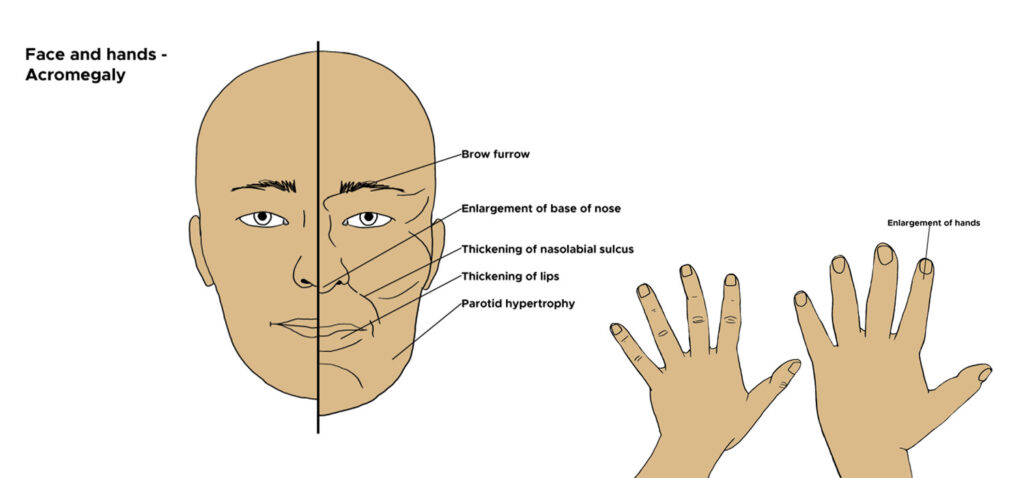Acromegaly is a rare hormonal disorder that occurs when the pituitary gland produces excessive growth hormone (GH), often due to a benign tumor called a pituitary adenoma. This condition primarily affects adults, leading to abnormal growth in bones and tissues, particularly in the hands, feet, and face. Early diagnosis and treatment are critical to managing acromegaly and preventing severe complications.

What is Acromegaly?
Acromegaly is characterized by an overproduction of growth hormone, which stimulates the liver to produce insulin-like growth factor 1 (IGF-1). Elevated levels of IGF-1 contribute to the abnormal growth associated with acromegaly. Although it typically develops slowly over years, untreated acromegaly can lead to serious health issues, including cardiovascular disease, diabetes, and joint problems.
Symptoms of Acromegaly
Symptoms of acromegaly often vary depending on the severity and duration of the condition. Common signs include:
- Enlarged Extremities: Noticeable growth in the hands, feet, and facial bones.
- Facial Changes: Prominent jawline, enlarged nose, and thickened lips.
- Joint Pain: Arthralgia caused by tissue overgrowth.
- Skin Changes: Thickened, oily, or rough skin.
- Excessive Sweating: Increased perspiration and body odor.
- Fatigue and Weakness: Reduced energy levels and muscle weakness.
- Vision Problems: Blurred or impaired vision due to tumor pressure on optic nerves.
- Headaches: Chronic headaches caused by the tumor.
Complications
If left untreated, acromegaly can lead to severe complications such as:
- Cardiovascular Issues: High blood pressure, heart disease, and cardiomyopathy.
- Diabetes Mellitus: Insulin resistance due to elevated growth hormone levels.
- Sleep Apnea: Obstructive sleep apnea caused by tissue growth in the airway.
- Carpal Tunnel Syndrome: Nerve compression in the wrists.
Causes
The primary cause of acromegaly is a pituitary adenoma, a non-cancerous tumor in the pituitary gland. Rarely, acromegaly can result from tumors in other parts of the body, such as the pancreas or lungs, which produce growth hormone-releasing hormone (GHRH).
Pituitary Adenoma
- Functioning Adenomas: These tumors produce excess growth hormone.
- Non-Functioning Adenomas: While they do not secrete hormones, they can still exert pressure on the surrounding pituitary gland.
Genetic Factors
While most cases of acromegaly are sporadic, genetic conditions like multiple endocrine neoplasia type 1 (MEN1) and McCune-Albright syndrome can increase susceptibility.
Diagnosis
Diagnosing acromegaly involves a combination of clinical evaluation, biochemical testing, and imaging studies.
Biochemical Tests
- IGF-1 Levels: Elevated IGF-1 levels are a hallmark of acromegaly.
- Oral Glucose Tolerance Test (OGTT): Growth hormone suppression failure during this test confirms the diagnosis.
Imaging Studies
- MRI of the Pituitary Gland: Identifies the presence and size of a pituitary adenoma.
- CT Scans: Used if MRI is unavailable or contraindicated.
Treatment Options
The goal of treatment is to normalize growth hormone and IGF-1 levels, alleviate symptoms, and manage tumor size. Options include:
Surgical Intervention
Transsphenoidal Surgery is the most effective treatment for removing pituitary adenomas. It is minimally invasive and often provides immediate relief from symptoms.
Medication Therapy
- Somatostatin Analogs (SSAs): Reduce growth hormone secretion (e.g., octreotide, lanreotide).
- Growth Hormone Receptor Antagonists: Block the effects of growth hormone (e.g., pegvisomant).
- Dopamine Agonists: Lower growth hormone levels in some patients (e.g., cabergoline).
Radiation Therapy
For patients who do not respond to surgery or medication, radiation therapy, such as stereotactic radiosurgery, may help shrink the tumor and reduce hormone levels.
Managing Acromegaly: Lifestyle and Support
In addition to medical treatments, patients can adopt strategies to manage symptoms and improve quality of life:
- Regular Monitoring: Frequent follow-ups to assess hormone levels and tumor size.
- Healthy Diet: A balanced diet to manage complications like diabetes.
- Physical Activity: Low-impact exercises to reduce joint pain and improve overall health.
- Emotional Support: Counseling or support groups to address mental health concerns.
Prognosis of Acromegaly
With early diagnosis and effective treatment, the prognosis for acromegaly improves significantly. Successful management can reduce complications, normalize hormone levels, and enhance the patient’s quality of life.

